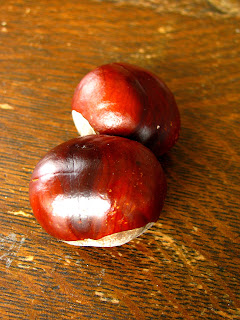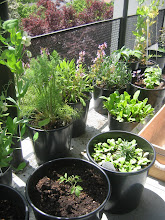Wednesday, October 31, 2012
Kouign Aman
I've been holding onto this set of recipes I clipped out of the paper for over a year now, because they look so delicious, and never had the guts to try it. The instructions are super complicated, and the pictures are all fancy. The article has this sidebar that says stuff like, 'Don't skip the 3 different resting times!' and 'Make sure the dough is cool, but not too cold!' and 'Don't worry if the first 7nty billion times you try it don't turn out right!' Either I have very low standards, or it isn't nearly as complex as the recipe says.
Use 1/2 recipe of the ubiquitous pizza dough. It's fine, or even better, if it has been sitting in the fridge for rather longer than you like to think about.
Let the dough sit on the counter for about an hour, lightly flour the rolling surface, and roll the dough into a mostly rectangular shape about 11" x 14". Take a stick of butter out of the fridge, and cut about 3 tablespoons worth of very thin shavings off it, and sprinkle them on 2/3 of the dough. Sprinkle a couple pinches of sugar over it.
Fold the un-buttered part of the dough over half the buttered part, then fold it again so all the butter is inside. Roll the dough out until it's about 8 x 12 inches, very lightly sprinkle it with flour and sugar, and fold it in 3 parts again.
Roll it out until it's about 5 x 10 inches, and fold it in 3 parts again. Pinch the sides of the folds together tightly, pat it into a ball, and put it on a pie plate. It'll be about the size of a baseball, but flatter. Sprinkle the outside generously with sugar, and put a bowl over it while you pre-heat the oven to 450. Once the oven is hot, cut 3 slashes in an asterisk shape about 1/3 the way through the dough, and sprinkle with sugar again to cover all the exposed insides of the cuts. Sprinkle a tiny pinch of salt on it. Bake for about 35 minutes.
Notes:
1. I suspect that leaving the dough until it is way over fermented helps it retain its layered structure. It also tastes more interesting.
2. If you aren't sure, be more generous with the butter. The butter is the main thing that keeps the dough from merging back into one big lump.
3. Use salted butter. And go heavy on the sugar on the outside.
4. If you have time, sure, you can let the dough rest between foldings. It will undoubtedly help create layering, but it's ok if you don't.
5. It will be sitting in a pool of melted butter by the time it's done. That's normal.
6. Eat it hot! It is not nearly as good cold, although it is ok if you toast it again later.
That's kinda it. The first time I tried it, my dough was about 10 days old, and it rose a lot less in the oven. On the other hand, the layers were more distinct. The second time, it was more bready, but still quite tasty. I think I squashed the dough a little too hard, and it merged the layers back together. But so what? I gather that these things were invented as a way to use up scraps of dough, so I think that having the process be somewhat approximate stays true to the original intent of just preventing waste. The name is some weird french dialect; it means Queen Anne. The shape of the bread is supposed to resemble a little crown.
Saturday, October 27, 2012
Apple Pie
 |
| mmmmm...pie |
I went to the apple festival at Portland Nursery the other weekend and bought 23 pounds of apples. I made a pie for my birthday. I have never been a big fan of apple pie. I prefer almost any kind of pie better than apple, to tell the truth. But, apples are what I have, and since I don't own a mixer that would enable me to make my favorite apple walnut cake, a pie it was.
My pie turned out so well that I started wondering why I thought I don't like apple pie. I do like apple pie, if it is good pie: the problem is that the world is full of middling-to-bleh apple pies. Store bought pie is almost invariably tough in the crust, which is a major strike against it. They are also horribly sweet, which is strike two. The coup de gras is usually the fact that the 'apples' in said pies are not generally recognizable as such. They are an evil combination of mushy and fibrous. There is neither taste nor aroma to indicate appleness. There is goo, and not in a good way.
This is a better pie.
Use this crust recipe. You can use part whole wheat if you like the texture, or all white if you prefer. I did all white to keep it simple.
Filling
2 lbs mixed apples. I got several kinds, I don't remember what, but they were mostly firm and tart.
about 1/2 cup sugar
a pinch each of freshly grated nutmeg and cinnamon
2 cloves, ground
a dab of butter
1/2 teaspoon vanilla
Begin to peel, core and chop the apples. As you are chopping them up, drop them into a medium-hot saucepan with the the butter. Keep adding apples as you peel, and stir in the sugar about halfway through the apples. Add the spices. Stir just enough to prevent the apples from browning very much. When you get to the end of the apples, some of them will be coming apart and some of them will be barely cooked. This is a good thing. Stir in the vanilla. Cover the pan and remove from heat while you roll out the bottom crust and arrange it in a 9" pan. Pour in the filling, top it with the other half of the pastry, and bake at 350 for about an hour or until the crust is as brown as you like it, that is, until you loose your patience and have to eat your pie right NOW.
Notes:
1. Apples are about the perfect pie fruit, apparently.
2. This is because they have a large amount of pectin in them.
3. Which is important, because pectin has the curious property of gelling up when cooked with both sugar and acid.
4. That means that it's important to put at least a little sugar in the filling as you cook it, especially if the apples are tart. Not enough sugar means the pectin won't thicken properly.
5. It also means that you should cook the apples first, because if you just put the raw apples in the crust, the pastry will burn before the apples are cooked on the inside, and the apples have to cook in order to activate the pectin.
What is pectin anyway? The Wikipedia page has way more technical stuff than I want to know, but the gist of it seems to be that pectin is a kind of dietary fiber found in fruits. People use it for a lot of things, most notably in making jam, because soft fruits like berries contain little pectin and will therefore make a very thin, soupy jam without adding some in.
My pie didn't last very long. It was tart and crispy edged when it was hot out of the oven, and it was sweeter and melty crusted for breakfast and lunch the next day. There was no goo. The apples cooked into a pleasant combination of firm fruity bits and sauce, with just enough spice to snazz it up.
Saturday, October 13, 2012
Chestnuts, or, Dude, you are so Asian
I found a chestnut tree! The kind that makes nuts you can eat! The other day I spent an hour stomping nut jackets in the gutter outside somebody I don't know's house! It didn't seem like nearly such a dodgy behavior at the time; I think my roots were showing. My crazy chinese roots, that is. In my defense, urban foraging is a very Portland thing to do. At least scrounging a bagful of fallen chestnuts on a shiny October morning is not like scrubbing around in the grass on your hands and knees looking for ginko nuts that smell like poo in the dark and the rain.
Plus, everybody knows that chestnuts are a thing you eat, providing that you get the kind that are edible. So how do you tell the difference? Wikipedia of course! But really, it's easy to tell. The edible kind is on the left. They have zebra stripes that go from top to bottom, and a little fuzzy tassel on the end. The tassel can get broken off, so the important part is the stripes.
 |
| wood grain = wouldn't eat that |
 |
| Stripes = sounds tasty to me. |
The ones that you can't eat are on the right. See how they have this subtle wood grain pattern? Also, no tassel. Not even a place where the tassel would be. Smooth as a baby's butt. Those are the kind called horse chestnuts. The jackets also look quite different. Horse chestnuts look like the head of a mace, with just a few big points on them. Sweet chestnuts look like a little green hedgehog. They have a dense covering of amazingly prickly spines, which is why you stomp them gently to get the nuts out. Wear stout shoes, and be careful not to bounce one up onto your ankle. Gloves would be a good idea too.
 |
| AKA 'conkers' |
 |
| imagine if that fell on you. |
Chestnuts are unusually low in fat and high in water and starch for nuts, making them vulnerable to dehydration and mildew. Unless you are going to eat them right away, you should freeze them. I put them in ziploc bags. Later, I'll investigate some recipes.
Subscribe to:
Posts (Atom)









